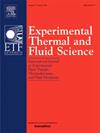Local heat transfer approach to the start-up analysis of an ultra-thin loop heat pipe
IF 2.8
2区 工程技术
Q2 ENGINEERING, MECHANICAL
Experimental Thermal and Fluid Science
Pub Date : 2025-01-22
DOI:10.1016/j.expthermflusci.2025.111421
引用次数: 0
Abstract
Loop heat pipes are two-phase, passive heat transfer devices that exhibit attractive features for thermal management applications, including micro-electronics and battery packs cooling. To enhance the modelling and optimization of such heat transfer devices, a better understanding of their working behaviour is needed, especially in terms of device response to start-up transients. To this aim, a novel local heat transfer approach is proposed and applied to the experimental investigation of a copper loop heat pipe partially filled with ethanol, whose ultra-thin layout has been specifically designed for embedment in electronic devices. The evaporator section is heated by means of an electrical resistance, while the condenser is cooled by free convection. The outer wall temperature along the whole condenser is monitored during the start-up phase of the device at varying heat loads through a medium-wave infrared camera. The temperature signals, referred to six wall sections, are post-processed by means of the Inverse Heat Conduction Problem resolution approach, resulting in the assessment of the heat fluxes exchanged between the working fluid and the device wall over time in both the vapor and liquid lines. The inverse method is successfully validated by means of synthetic data, whereas the experimental procedure is calibrated and verified by preliminary experimental tests. Start-up results show comparable trends in the wall-to-fluid heat flux profiles with the heat input, exhibiting peak values of about 2300 W/m2. Through the present non-intrusive technique, fluid velocity in the vapour line is also estimated in the range 0.008 - 0.012 m/s. To the authors’ knowledge, this represents one of the first attempts of characterizing both local heat transfer quantities and inner fluid dynamics in loop heat pipes via experimental approaches.
超薄环形热管启动分析的局部传热方法
环路热管是两相被动传热装置,在热管理应用中具有吸引人的功能,包括微电子和电池组冷却。为了加强这种传热装置的建模和优化,需要更好地了解它们的工作行为,特别是在设备对启动瞬态的响应方面。为此,提出了一种新的局部传热方法,并将其应用于部分填充乙醇的铜环路热管的实验研究,该热管的超薄布局是专门为嵌入电子设备而设计的。蒸发器部分通过电阻加热,而冷凝器通过自由对流冷却。在装置启动阶段,通过中波红外摄像机监测整个冷凝器在不同热负荷下的外壁温度。通过反热传导问题解决方法对涉及六个壁段的温度信号进行后处理,从而评估在蒸汽和液体管道中工作流体和设备壁之间随时间交换的热流。通过综合数据对反演方法进行了验证,通过初步实验对实验步骤进行了标定和验证。启动结果显示,壁面到流体的热流密度曲线与热输入有相似的趋势,峰值约为2300 W/m2。通过目前的非侵入式技术,估计了蒸汽线上的流体速度在0.008 - 0.012 m/s范围内。据作者所知,这代表了通过实验方法表征局部传热量和循环热管内部流体动力学的首次尝试之一。
本文章由计算机程序翻译,如有差异,请以英文原文为准。
求助全文
约1分钟内获得全文
求助全文
来源期刊

Experimental Thermal and Fluid Science
工程技术-工程:机械
CiteScore
6.70
自引率
3.10%
发文量
159
审稿时长
34 days
期刊介绍:
Experimental Thermal and Fluid Science provides a forum for research emphasizing experimental work that enhances fundamental understanding of heat transfer, thermodynamics, and fluid mechanics. In addition to the principal areas of research, the journal covers research results in related fields, including combined heat and mass transfer, flows with phase transition, micro- and nano-scale systems, multiphase flow, combustion, radiative transfer, porous media, cryogenics, turbulence, and novel experimental techniques.
 求助内容:
求助内容: 应助结果提醒方式:
应助结果提醒方式:


